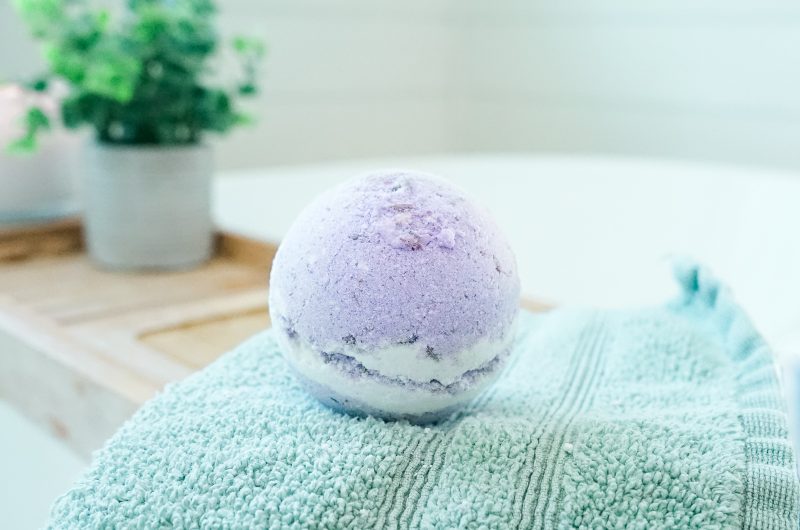Ahhhh lavender. You can almost smell it just hearing the word, and there’s a good reason for that. With its unmistakable scent and therapeutic benefits, lavender has been used in aromatherapy for centuries to aid relaxation and reduce stress – making it the perfect ingredient for our latest DIY project: a calming lavender bath bomb!
Today, we’ll show you our favorite recipe (including one secret ingredient) so you can mix up your own fragrant bath bombs without any fuss or fancy equipment. We promise this will be an easy-breezy experience — no explosive accidents here…just gentle fizz with plenty of R&R along the way!
What’s in This Bath Bomb Recipe
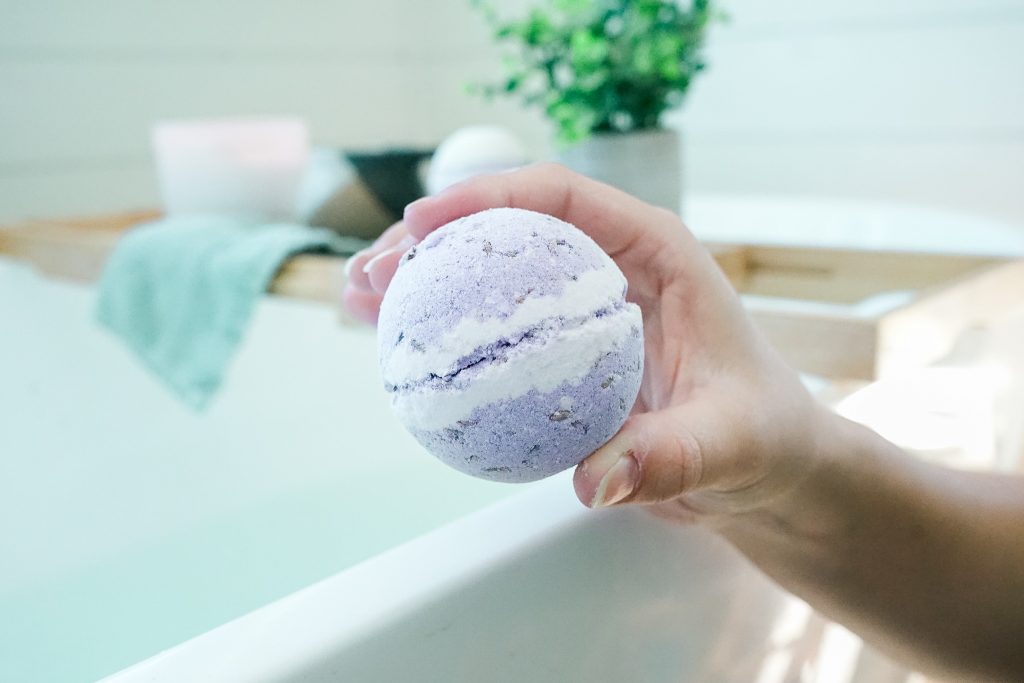
Almond Oil
Add almond oil or any other carrier oil to your mix and it will help bind all the ingredients of your bath bomb together while also diluting the essential oils included so all the calming and soothing effects aren’t too intense!
Emulsifying Wax (Secret Ingredient)
Make your bath bomb recipe go from good to grand with emulsifying wax! Once incorporated into the recipe of the bath bomb, it helps to make it extra bubbly! Moreover, it also helps to mix those essential oils and mica powder effortlessly with the water.
Lavender Essential Oil
Not only does Lavender essential oil have the dreamy, floral scent of comfort that we all crave in relaxing times, but it’s also packed with more thoughtful benefits. It’s both calming and uplifting, and it has beneficial properties that can help soothe skin afterward.
Citric Acid
One crucial ingredient in crafting such a blissful bath bomb is citric acid, which not only helps create those satisfying fizzing bubbles in contact with water but has natural cleaning properties that will leave you feeling softer and smoother than before.
Violet Mica Powder
With the addition of violet mica powder to your lavender bath bomb, you can take your relaxation ritual to the next level. Not only will it provide a soothing scent and delightful fizzy or in the bath – but with just a sprinkle of this whimsical ingredient, you can also indulge in beautiful ombre blues, purples, and violets twinkling around you as you soak into luxurious serenity.
Lavender Buds
Who doesn’t love having a nice visual in their bubble-filled haven? Lavender buds are the perfect ingredient to fill your tub with because of their calming properties. Just dropping these delicate purple buds into the bath will instantly fill your space with a peacefulness that’ll have you reaching for that book and glass of wine real quick!
Baking Soda
Baking soda is essential to a bath bomb, as it helps create that satisfying fizz when it’s dropped into some water and provides rather pleasant external effects. Not only can baking soda help balance pH levels in your skin, but it also has skin-calming and soothing effects.
Corn Starch
Take your bath-time experience up a notch with cornstarch! Its creamy consistency will give you silky, luxe-like vibes every single time. Not to mention, it will also slow down the fizzing reaction of your calming lavender bomb—which we all love.
Isopropyl Alcohol (or Witch Hazel)
Isopropyl alcohol or witch hazel is a natural and skin-friendly ingredient in this bath bomb. Not only does it make the bath bombs stick together better when soaking, but it’s also gentle and even provides skincare benefits!
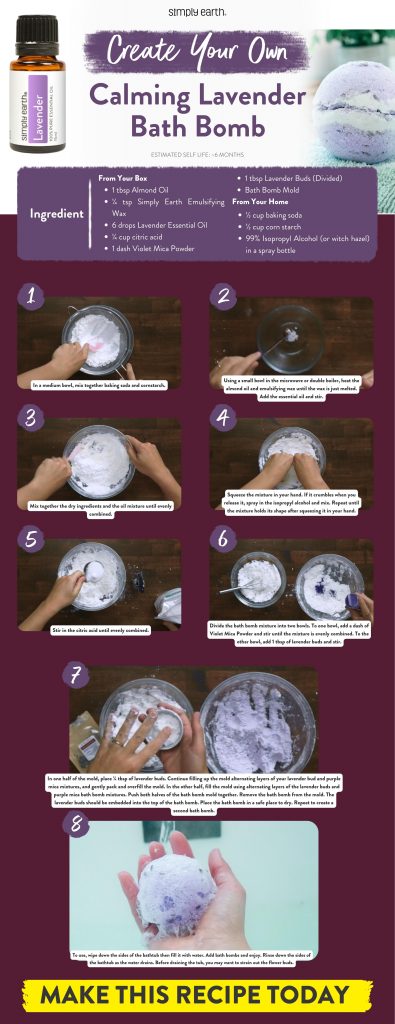
Things to Remember When Using This Recipe

Always dilute an essential oil when using it on the skin. This essential oil recipe is unlikely to cause skin irritation when diluted properly. If the oil has oxidized (been left with the cap off for long periods of time), it is more likely to cause skin irritation. Check out this dilution chart for diluting this essential oil properly.

If you are pregnant, consult your doctor prior to use.

This recipe is safe to use with kids aged 2+.

For more information on using essential oils with cats, check out this blog post.

This essential oil recipe is generally safe to use around dogs. For more information on using essential oils with dogs, check out this blog post.
We don’t recommend ingesting essential oils unless under the direction of a doctor certified in aromatherapy. For more information on why we don’t ingest essential oils check out this blog post.
*Please note: This post is a compilation of suggestions made by those that have extensively used essential oils and has not been verified scientifically with clinical tests nor reviewed by medical experts. It is anecdotal information and should be treated as such. For serious medical concerns, please consult your doctor. The statements given in this blog post have not been verified by the FDA
Calming Lavender Bath Bomb Recipe
Calming Lavender Bath Bomb Recipe + Secret Ingredient
Ingredients
- From Simply Earth
1 tbsp Almond Oil
¼ tsp Simply Earth Emulsifying Wax
6 drops Lavender Essential Oil
¼ cup citric acid
1 dash Violet Mica Powder
1 tbsp Lavender Buds (Divided)
Bath Bomb Mold
- From Your Home
½ cup baking soda
½ cup cornstarch
99% Isopropyl Alcohol (or witch hazel) in a spray bottle
Directions
- In a medium bowl, mix together baking soda and cornstarch.
- Using a small bowl in the microwave or double boiler, heat the almond oil and emulsifying wax until the wax is just melted. Add the essential oil and stir.
- Mix together the dry ingredients and the oil mixture until evenly combined.
- Squeeze the mixture in your hand. If it crumbles when you release it, spray in the isopropyl alcohol and mix. Repeat until the mixture holds its shape after squeezing it in your hand.
- Stir in the citric acid until evenly combined.
- Divide the bath bomb mixture into two bowls. To one bowl, add a dash of Violet Mica Powder and stir until the mixture is evenly combined. To the other bowl, add 1 tbsp of lavender buds and stir.
- In one half of the mold, place ¼ tbsp of lavender buds. Continue filling up the mold alternating layers of your lavender bud and purple mica mixtures, and gently pack and overfill the mold. In the other half, fill the mold using alternating layers of the lavender buds and purple mica bath bomb mixtures. Push both halves of the bath bomb mold together. Remove the bath bomb from the mold. The lavender buds should be embedded into the top of the bath bomb. Place the bath bomb in a safe place to dry. Repeat to create a second bath bomb.
- To use, wipe down the sides of the bathtub then fill it with water. Add bath bombs and enjoy. Rinse down the sides of the bathtub as the water drains. Before draining the tub, you may want to strain out the flower buds.
Tips for Making Calming Lavender Bath Bombs
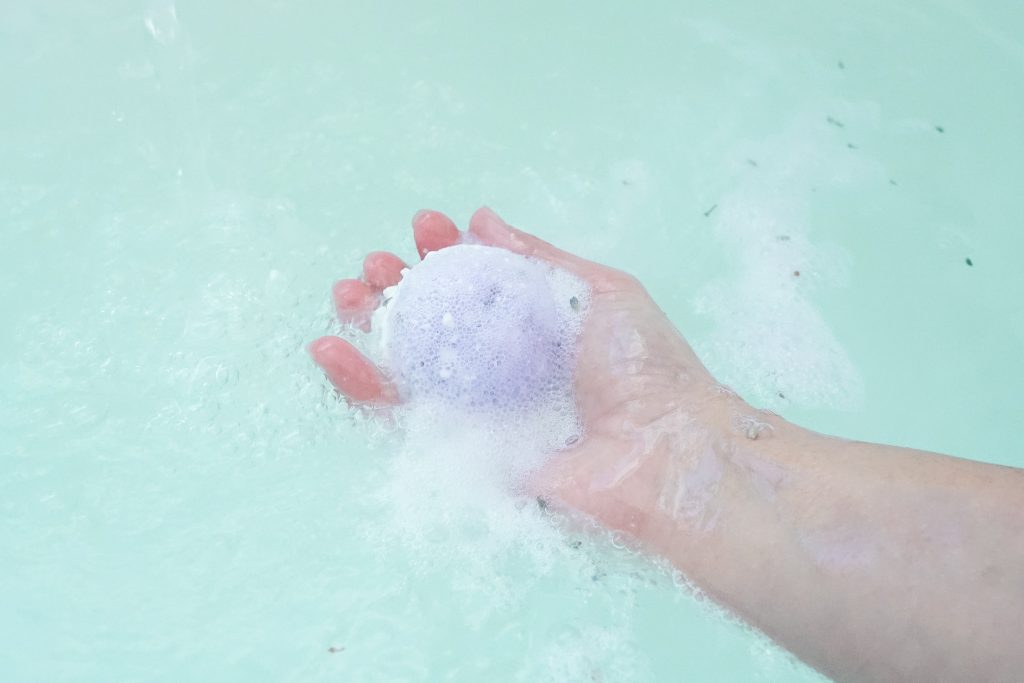
1.Get the Right Consistency
The most important tip for making bath bombs is to make sure you get the consistency right. Once you have all your ingredients mixed together, squeeze the mixture into your hand. If it doesn’t hold together like a snowball, you need to add more isopropyl alcohol.
2.Consider Wearing Gloves
If you have sensitive skin, or nail polish, or are making bath bombs for someone else, you should wear gloves while making bath bombs. Citric acid can rub away nail polish and irritate some people with sensitive skin (however this typically isn’t an issue when it’s added to the bath).
3.Consider Wearing A Mask
Baking soda and mica powders are very fine powders. They will go airborne when you add them to your mixture. This can be irritating to those with sensitive lungs. This is true of clays and mica powders (or any other fine powder) you may be adding to your bath bombs. You can wear a mask while you make bath bombs to prevent irritation.
4.Humidity
Humidity can be a big factor in the success or failure of bath bombs. Try not to make bath bombs when it rains. If you live in a humid environment, run a humidifier while you make your bath bombs and while they dry so that the water in the air doesn’t cause them to react prematurely.
5.There’s No Such Thing As Failure in Bath Bombs
If your bath bomb mixture isn’t turning out visually how you’d like, don’t count it as a failure. You can still add your mixture to a bath for fizzy, bubbly fun.
6.Clean Your Tub
Mica powder has a tendency to stick to soap scum on the sides of bathtubs. Adding emulsifying wax to this recipe helps prevent that, but it’s always a good idea to give your tub a quick clean before using a bath bomb. As the tub drains, wash down the sides of the tub to make sure all the mica powder goes down the drain rather than sticking to your tub.
TIP: If you’re worried about mica powder sticking to your tub, you can skip it and have a white beautiful bath bomb.
Check Out This Calming Lavender Bath Bomb Recipe Cheat Sheet!
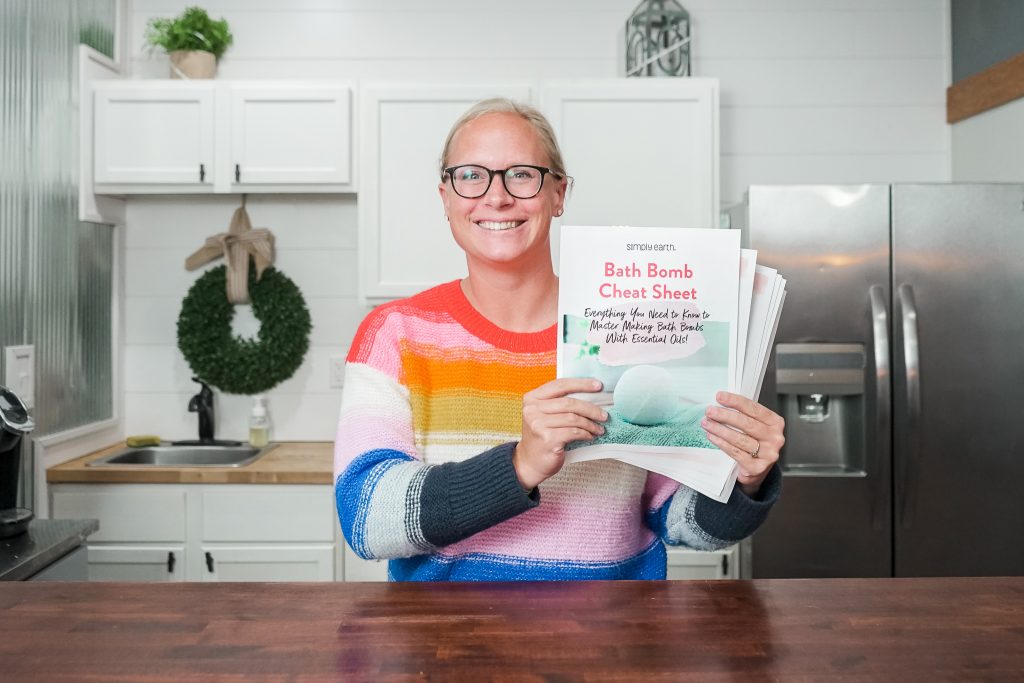
Have you ever wanted to make your own bath bombs but hesitated to try them due to the complexity and steep learning curve? Let us assure you that making your own lavender bath bombs is so much easier than you think! Presenting you with this unparalleled cheat sheet, where we’ve outlined all the necessary ingredients, step-by-step instructions for mixing and molding, and tips for packing and storing. Download our bath bomb cheat sheet today and be immersed in a blissful world of calming lavender scents whenever you take a luxuriating soak.


